
Color blindness, also known as color vision deficiency, is the decreased ability to see color or differences in color. Simple tasks such as selecting ripe fruit, choosing clothing, and reading traffic lights can be more challenging. Color blindness may also make some educational activities more difficult. However, problems are generally minor, and most people find that they can adapt. People with total color blindness (achromatopsia) may also have decreased visual acuity and be uncomfortable in bright environments.
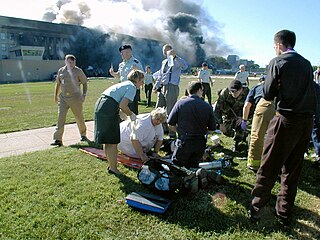
Triage is the process of determining the priority of patients' treatments based on the severity of their condition. This rations patient treatment efficiently when resources are insufficient for all to be treated immediately. The term comes from the French verb trier, meaning to separate, sift or select. Triage may result in determining the order and priority of emergency treatment, the order and priority of emergency transport, or the transport destination for the patient.

An electronic color code is used to indicate the values or ratings of electronic components, usually for resistors, but also for capacitors, inductors, diodes and others. A separate code, the 25-pair color code, is used to identify wires in some telecommunications cables. Different codes are used for wire leads on devices such as transformers or in building wiring.

Traffic lights, also known as traffic signals, traffic lamps, traffic semaphore, signal lights, stop lights, robots, and traffic control signals, are signalling devices positioned at road intersections, pedestrian crossings, and other locations to control flows of traffic.

A vehicle registration plate, also known as a number plate or a license plate, is a metal or plastic plate attached to a motor vehicle or trailer for official identification purposes. All countries require registration plates for road vehicles such as cars, trucks, and motorcycles. Whether they are required for other vehicles, such as bicycles, boats, or tractors, may vary by jurisdiction. The registration identifier is a numeric or alphanumeric ID that uniquely identifies the vehicle owner within the issuing region's vehicle register. In some countries, the identifier is unique within the entire country, while in others it is unique within a state or province. Whether the identifier is associated with a vehicle or a person also varies by issuing agency. There are also electronic license plates.
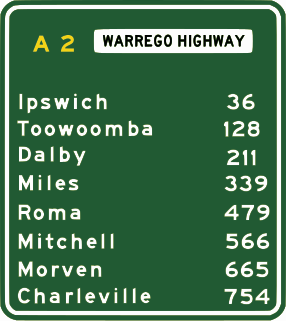
Traffic signs or road signs are signs erected at the side of or above roads to give instructions or provide information to road users. The earliest signs were simple wooden or stone milestones. Later, signs with directional arms were introduced, for example, the fingerposts in the United Kingdom and their wooden counterparts in Saxony.
In computing, on the X Window System, X11 color names are represented in a simple text file, which maps certain strings to RGB color values. It was traditionally shipped with every X11 installation, hence the name, and is usually located in <X11root>/lib/X11/rgb.txt. The web colors list is descended from it but differs for certain color names.
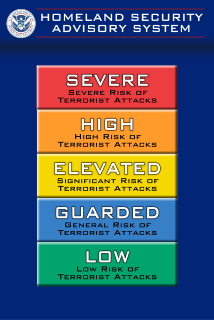
In the United States, the Homeland Security Advisory System was a color-coded terrorism threat advisory scale. The different levels triggered specific actions by federal agencies and state and local governments, and they affected the level of security at some airports and other public facilities. It was often called the "terror alert level" by the U.S. media. The system was replaced on April 27, 2011, with a new system called the National Terrorism Advisory System.
Yellow badges, also referred to as Jewish badges, are badges that Jews were ordered to wear in public during certain periods by the ruling Christians and Muslims. The badges served to mark the wearer as a religious outsider, and often served as a badge of shame.

Political colours are colours used to represent a political party, either officially or unofficially. Parties in different countries with similar ideologies sometimes use similar colours. For example, the colour red symbolises left-wing ideologies in many countries while the colour orange symbolizes Christian democratic political ideology. However, the political associations of a given colour vary from country to country: red is also the colour associated with the conservative Republican Party in the United States. Politicians making public appearances will often identify themselves by wearing rosettes, flowers or ties in the colour of their political party.

The flag of Lithuania consists of a horizontal tricolor of yellow, green, and red. It was adopted on 25 April 1918 during Lithuania's first period of independence from 1918 to 1940, which ceased with the occupation first by Soviet Russia and Lithuania's annexation into the Soviet Union, and then by Nazi Germany (1941–1944). During the post-World War II Soviet occupation, from 1945 until 1989, the Soviet Lithuanian flag consisted first of a generic red Soviet flag with the name of the republic, then changed to the red flag with white and green bars at the bottom.

A building code is a set of rules that specify the standards for constructed objects such as buildings and nonbuilding structures. Buildings must conform to the code to obtain planning permission, usually from a local council. The main purpose of building codes is to protect public health, safety and general welfare as they relate to the construction and occupancy of buildings and structures. The building code becomes law of a particular jurisdiction when formally enacted by the appropriate governmental or private authority.
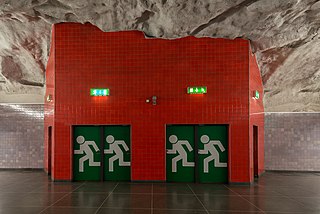
An emergency exit in a structure is a special exit for emergencies such as a fire: the combined use of regular and special exits allows for faster evacuation, while it also provides an alternative if the route to the regular exit is blocked by fire, etc.
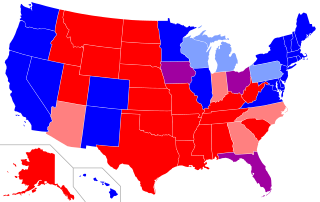
Since the 2000 United States presidential election, red states and blue states have referred to states of the United States whose voters predominantly choose either the Republican Party (red) or Democratic Party (blue) presidential candidates. Since then, the use of the term has been expanded to differentiate between states being perceived as liberal and those perceived as conservative. Examining patterns within states reveals that the reversal of the two parties' geographic bases has happened at the state level, but it is more complicated locally, with urban/rural divides associated with many of the largest changes.

All motorised road vehicles in India are tagged with a registration or license number. The Vehicle registration plate number is issued by the district-level Regional Transport Office (RTO) of respective states — the main authority on road matters. The number plates are placed in the front and back of the vehicle. By law, all plates are required to be in modern Hindu-Arabic numerals with Latin letters. Other guidelines include having the plate lit up at night and the restriction of the fonts that could be used. In some states such as Sikkim, cars bearing outside plates are barred from entering restricted areas. The international vehicle registration code for India is IND.

Emergency vehicle lighting is one or more visual warning lights fitted to a vehicle for use when the driver wishes to convey to other road users the urgency of their journey, to provide additional warning of a hazard when stationary, or in the case of law enforcement as a means of signalling another driver to stop for interaction with an officer. These lights may be dedicated emergency lights, such as a beacon or a light bar, or may be modified stock lighting, such as a wig-wag or hide-away light, and are additional to any standard lighting on the car such as hazard lights. Often, they are used along with a siren in order to increase their effectiveness. In many jurisdictions, the use of these lights may afford the user specific legal powers, and may place requirements on other road users to behave differently, such as compelling them to pull to the side of the road and yield right of way so the emergency vehicle may proceed through unimpeded.
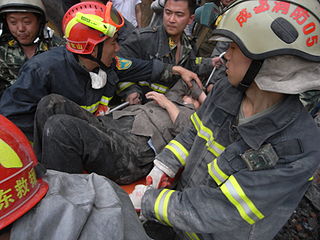
Urban Search and Rescue involves the location, extrication, and initial medical stabilization of victims trapped in structural collapse due to natural disasters, mines and collapsed trenches.
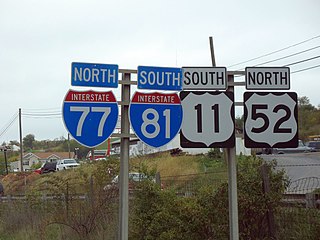
A highway shield or route marker is a sign denoting the route number of a highway, usually in the form of a symbolic shape with the route number enclosed. As the focus of the sign, the route number is usually the sign's largest element, with other items on the sign rendered in smaller sizes or contrasting colors. Highway shields are used by travellers, commuters, and all levels of government for identifying, navigating, and organising routes within a county, state, province, or country. Simplified highway shields often appear on maps.

Barricade tape is brightly colored tape that is used to warn or catch the attention of passersby of an area or situation containing a possible hazard. It acts as a minor impediment to prevent accidental entrance to that area or situation and as a result enhances general safety. Barricade tape is also known as construction tape or barrier tape or in reference to the safety hazard involved as caution tape, warning tape, danger tape or hazard tape. When used by a police force, the tape is named police tape.

An exit sign is a device in a public facility denoting the location of the closest emergency exit in case of fire or other emergency. Most relevant codes require exit signs to be permanently lit.





















